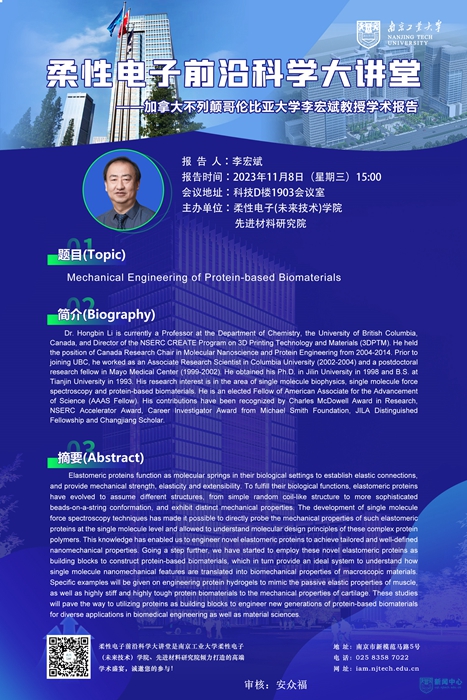学术活动 NAVIGATION
Mechanical Engineering of Protein-based Biomaterials
报告题目:Mechanical Engineering of Protein-based Biomaterials
报告人:李宏斌教授
报告人单位:加拿大不列颠哥伦比亚大学
报告时间:2023年11月8日(周三)15:00
会议地点:科技D楼1903会议室
举办单位:柔性电子(未来技术)学院、先进材料研究院
报告人简介:Dr. Hongbin Li is currently a Professor at the Department of Chemistry, the University of British Columbia, Canada, and Director of the NSERC CREATE Program on 3D Printing Technology and Materials (3DPTM). He held the position of Canada Research Chair in Molecular Nanoscience and Protein Engineering from 2004-2014. Prior to joining UBC, he worked as an Associate Research Scientist in Columbia University (2002-2004) and a postdoctoral research fellow in Mayo Medical Center (1999-2002). He obtained his Ph.D. in Jilin University in 1998 and B.S. at Tianjin University in 1993. His research interest is in the area of single molecule biophysics, single molecule force spectroscopy and protein-based biomaterials. He is an elected Fellow of American Associate for the Advancement of Science (AAAS Fellow). His contributions have been recognized by Charles McDowell Award in Research, NSERC Accelerator Award, Career Investigator Award from Michael Smith Foundation, JILA Distinguished Fellowship and Changjiang Scholar.
报告摘要:Elastomeric proteins function as molecular springs in their biological settings to establish elastic connections, and provide mechanical strength, elasticity and extensibility. To fulfill their biological functions, elastomeric proteins have evolved to assume different structures, from simple random coil-like structure to more sophisticated beads-on-a-string conformation, and exhibit distinct mechanical properties. The development of single molecule force spectroscopy techniques has made it possible to directly probe the mechanical properties of such elastomeric proteins at the single molecule level and allowed to understand molecular design principles of these complex protein polymers. This knowledge has enabled us to engineer novel elastomeric proteins to achieve tailored and well-defined nanomechanical properties. Going a step further, we have started to employ these novel elastomeric proteins as building blocks to construct protein-based biomaterials, which in turn provide an ideal system to understand how single molecule nanomechanical features are translated into biomechanical properties of macroscopic materials. Specific examples will be given on engineering protein hydrogels to mimic the passive elastic properties of muscle, as well as highly stiff and highly tough protein biomaterials to the mechanical properties of cartilage. These studies will pave the way to utilizing proteins as building blocks to engineer new generations of protein-based biomaterials for diverse applications in biomedical engineering as well as material sciences.
审核:安众福






 公网安备32011102010195号
公网安备32011102010195号